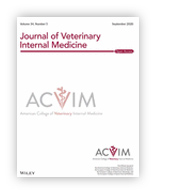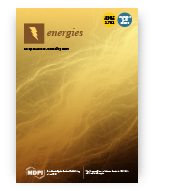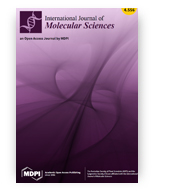Ubiquitin‐specific protease 7 as a potential therapeutic target in dogs with hematopoietic malignancies
Aleksandra Pawlak, Joanna Bajzert, Katarzyna Bugiel, Beatriz Hernandez Suarez, Kutkowska Justyna, Andrzej Rapak, Wojciech Hildebrand, Bożena Obmińska-Mrukowicz, Raimundo Freire, Veronique A. J. Smits
Journal of Veterinary Internal Medicine
 Background: Ubiquitin‐specific protease 7 (USP7) belongs to the group of deubiquitinating enzymes (DUBs), which remove ubiquitin which controls various cellular processes such as chromosome segregation, DNA repair, gene expression, protein localization, kinase activity, protein degradation, cell cycle progression, and apoptosis. It is critical for several important functions in the cell, and therefore dysregulation of USP7 can contribute to tumorigenesis. Objectives Alterations in the USP7 protein have been identified in various malignancies of humans. Our aim was to examine whether USP7 could be a potential therapeutic target in hematopoietic cancers of dogs. Methods: The expression level of USP7 in lymphocytes from healthy dogs and canine lymphoma cells was determined, and the effect of USP7 inhibition on the vital functions of canine cancer cells was examined. Results: We showed that USP7 was overexpressed in lymphomas in dogs. The USP7 inhibitor P5091 has selective cytotoxic activity in canine lymphoma and leukemia cell lines. Our results indicate that inhibition of USP7 leads to a disruption of cell cycle progression, and triggers DNA damage and apoptosis. The observed proapoptotic effect of the USP7 inhibitor most likely is not dependent on the p53 pathway. Conclusions and Clinical Importance: Our results suggest that USP7 could be explored as a potential therapeutic target in dogs with lymphoma. The effectiveness of USP7 inhibition in malignant cells is predicted to be independent of their p53 status.
Background: Ubiquitin‐specific protease 7 (USP7) belongs to the group of deubiquitinating enzymes (DUBs), which remove ubiquitin which controls various cellular processes such as chromosome segregation, DNA repair, gene expression, protein localization, kinase activity, protein degradation, cell cycle progression, and apoptosis. It is critical for several important functions in the cell, and therefore dysregulation of USP7 can contribute to tumorigenesis. Objectives Alterations in the USP7 protein have been identified in various malignancies of humans. Our aim was to examine whether USP7 could be a potential therapeutic target in hematopoietic cancers of dogs. Methods: The expression level of USP7 in lymphocytes from healthy dogs and canine lymphoma cells was determined, and the effect of USP7 inhibition on the vital functions of canine cancer cells was examined. Results: We showed that USP7 was overexpressed in lymphomas in dogs. The USP7 inhibitor P5091 has selective cytotoxic activity in canine lymphoma and leukemia cell lines. Our results indicate that inhibition of USP7 leads to a disruption of cell cycle progression, and triggers DNA damage and apoptosis. The observed proapoptotic effect of the USP7 inhibitor most likely is not dependent on the p53 pathway. Conclusions and Clinical Importance: Our results suggest that USP7 could be explored as a potential therapeutic target in dogs with lymphoma. The effectiveness of USP7 inhibition in malignant cells is predicted to be independent of their p53 status.
10.1111/jvim.16082
Enhancement of Food Waste Management and Its Environmental Consequences
Jan Den Boer, Gudrun Obersteiner, Sebastian Gollnow, Emilia Den Boer, Renata Bodnárné Sándor
Energies
 This paper assesses the potential environmental effects of the optimization of the kitchen waste management in Opole. The separate collection of kitchen waste is improved by distribution of separate collection kits consisting of an in-home bin and 10 L biodegradable bags. The surplus of collected kitchen waste is diverted from treatment in a mechanical-biological pretreatment (MBP) along with the residual waste to anaerobic digestion (AD) with the biowaste. This has positive effects on European and Polish goals, ambitions, and targets, such as (i) increasing the level of renewables in the primary energy supply, (ii) decreasing the level of greenhouse gas (GHG) emissions, (iii) increasing the level of preparation for reuse and recycling of municipal waste. The environmental effects of 1 ton additionally separately collected and treated kitchen waste are determined by using life cycle assessment. It was shown that in all selected impact categories (global warming potential, marine eutrophication potential, acidification potential, and ozone depletion potential) a clear environmental benefit can be achieved. These benefits are mainly caused by the avoided emissions of electricity and heat from the Polish production mix, which are substituted by energy generation from biogas combustion. Optimization of the waste management system by diversion of kitchen waste from mechanical-biological pretreatment to anaerobic digestion can lead to considerable saving of 448 kg CO2-eq/t of waste diverted. With an estimated optimization potential for the demonstration site of 40 kg/inh·year for the city of Opole, this would lead to 680,000 t CO2-eq savings per year for the whole of Poland. The sensitivity analysis showed that with a choice for cleaner energy sources the results would, albeit lower, show a significant savings potential.
This paper assesses the potential environmental effects of the optimization of the kitchen waste management in Opole. The separate collection of kitchen waste is improved by distribution of separate collection kits consisting of an in-home bin and 10 L biodegradable bags. The surplus of collected kitchen waste is diverted from treatment in a mechanical-biological pretreatment (MBP) along with the residual waste to anaerobic digestion (AD) with the biowaste. This has positive effects on European and Polish goals, ambitions, and targets, such as (i) increasing the level of renewables in the primary energy supply, (ii) decreasing the level of greenhouse gas (GHG) emissions, (iii) increasing the level of preparation for reuse and recycling of municipal waste. The environmental effects of 1 ton additionally separately collected and treated kitchen waste are determined by using life cycle assessment. It was shown that in all selected impact categories (global warming potential, marine eutrophication potential, acidification potential, and ozone depletion potential) a clear environmental benefit can be achieved. These benefits are mainly caused by the avoided emissions of electricity and heat from the Polish production mix, which are substituted by energy generation from biogas combustion. Optimization of the waste management system by diversion of kitchen waste from mechanical-biological pretreatment to anaerobic digestion can lead to considerable saving of 448 kg CO2-eq/t of waste diverted. With an estimated optimization potential for the demonstration site of 40 kg/inh·year for the city of Opole, this would lead to 680,000 t CO2-eq savings per year for the whole of Poland. The sensitivity analysis showed that with a choice for cleaner energy sources the results would, albeit lower, show a significant savings potential.
10.3390/en14061790
Myricetin as an Antivirulence Compound Interfering with a Morphological Transformation into Coccoid Forms and Potentiating Activity of Antibiotics against Helicobacter pylori
Paweł Krzyżek, Paweł Migdał, Emil Paluch, Magdalena Karwańska, Alina Wieliczko, Grażyna Gościniak
International Journal of Molecular Sciences
 Helicobacter pylori, a gastric pathogen associated with a broad range of stomach diseases, has a high tendency to become resistant to antibiotics. One of the most important factors related to therapeutic failures is its ability to change from a spiral to a coccoid form. Therefore, the main aim of our original article was to determine the influence of myricetin, a natural compound with an antivirulence action, on the morphological transformation of H. pylori and check the potential of myricetin to increase the activity of antibiotics against this pathogen. We observed that sub-minimal inhibitory concentrations (sub-MICs) of this compound have the ability to slow down the process of transformation into coccoid forms and reduce biofilm formation of this bacterium. Using checkerboard assays, we noticed that the exposure of H. pylori to sub-MICs of myricetin enabled a 4–16-fold reduction in MICs of all classically used antibiotics (amoxicillin, clarithromycin, tetracycline, metronidazole, and levofloxacin). Additionally, RT-qPCR studies of genes related to the H. pylori morphogenesis showed a decrease in their expression during exposure to myricetin. This inhibitory effect was more strongly seen for genes involved in the muropeptide monomers shortening (csd3, csd6, csd4, and amiA), suggesting their significant participation in the spiral-to-coccoid transition. To our knowledge, this is the first research showing the ability of any compound to synergistically interact with all five antibiotics against H. pylori and the first one showing the capacity of a natural substance to interfere with the morphological transition of H. pylori from spiral to coccoid forms.
Helicobacter pylori, a gastric pathogen associated with a broad range of stomach diseases, has a high tendency to become resistant to antibiotics. One of the most important factors related to therapeutic failures is its ability to change from a spiral to a coccoid form. Therefore, the main aim of our original article was to determine the influence of myricetin, a natural compound with an antivirulence action, on the morphological transformation of H. pylori and check the potential of myricetin to increase the activity of antibiotics against this pathogen. We observed that sub-minimal inhibitory concentrations (sub-MICs) of this compound have the ability to slow down the process of transformation into coccoid forms and reduce biofilm formation of this bacterium. Using checkerboard assays, we noticed that the exposure of H. pylori to sub-MICs of myricetin enabled a 4–16-fold reduction in MICs of all classically used antibiotics (amoxicillin, clarithromycin, tetracycline, metronidazole, and levofloxacin). Additionally, RT-qPCR studies of genes related to the H. pylori morphogenesis showed a decrease in their expression during exposure to myricetin. This inhibitory effect was more strongly seen for genes involved in the muropeptide monomers shortening (csd3, csd6, csd4, and amiA), suggesting their significant participation in the spiral-to-coccoid transition. To our knowledge, this is the first research showing the ability of any compound to synergistically interact with all five antibiotics against H. pylori and the first one showing the capacity of a natural substance to interfere with the morphological transition of H. pylori from spiral to coccoid forms.
10.3390/ijms22052695
Potential Enhancement of Metformin Hydrochloride in Lipid Vesicles Targeting Therapeutic Efficacy in Diabetic Treatment
Emmanuel Chekwube Ossai, Augustine Chidi Madueke, Benjamin Emenike Amadi, Martins Obinna Ogugofor, Audu Mumuni Momoh, Charles Okpala, Chioma Assumpta Anosike, Obioma Uzoma Njoku
International Journal of Molecular Sciences
 The potential enhancement of metformin hydrochloride (MH) loaded in lipid vesicles targeting therapeutic efficacy on alloxan-induced diabetic rats was investigated. This involved lipid vesicles formulated with homogenously distributed nano-sized particles by a novel integrated process of multiple emulsification by membrane and solvent evaporation. The average diameter of the water-in-oil (W1/O), W1/O/W2 emulsion droplets, and lipid vesicles was 192 nm, 52 µm, and 173 nm, respectively. The entrapment yield of metformin hydrochloride (MH) in the prepared lipid vesicles was 40.12%. The metformin hydrochloride-loaded lipid vesicles (MH-LLVs) sustained the release of the entrapped drug over a 12-h period and reduced the plasma glucose level of diabetic rats by 77.4% compared with free MH solution (2-h period and 58.2%, respectively) after one week post-diabetic treatment through oral administration of MH-LLV and the free drug. The remarkable improvement in the biochemical parameters recorded in the MH-LLV-treated animals compared with those that received free MH solutions depicted an enhanced kidney function, liver function, as well as oxidative stress status. Pancreatic histology depicted a pancreas with intralobular ducts (ID) and exocrine secretory acini that characterize an intact pancreas, which suggests the ability of the MH-LLVs to restore pancreatic cells to normal, on a continued treatment. Overall, MH-LLV appears an encouraging extended-release formulation with enhanced bioavailability, sustained release, and improved antihyperglycemic potentials.
The potential enhancement of metformin hydrochloride (MH) loaded in lipid vesicles targeting therapeutic efficacy on alloxan-induced diabetic rats was investigated. This involved lipid vesicles formulated with homogenously distributed nano-sized particles by a novel integrated process of multiple emulsification by membrane and solvent evaporation. The average diameter of the water-in-oil (W1/O), W1/O/W2 emulsion droplets, and lipid vesicles was 192 nm, 52 µm, and 173 nm, respectively. The entrapment yield of metformin hydrochloride (MH) in the prepared lipid vesicles was 40.12%. The metformin hydrochloride-loaded lipid vesicles (MH-LLVs) sustained the release of the entrapped drug over a 12-h period and reduced the plasma glucose level of diabetic rats by 77.4% compared with free MH solution (2-h period and 58.2%, respectively) after one week post-diabetic treatment through oral administration of MH-LLV and the free drug. The remarkable improvement in the biochemical parameters recorded in the MH-LLV-treated animals compared with those that received free MH solutions depicted an enhanced kidney function, liver function, as well as oxidative stress status. Pancreatic histology depicted a pancreas with intralobular ducts (ID) and exocrine secretory acini that characterize an intact pancreas, which suggests the ability of the MH-LLVs to restore pancreatic cells to normal, on a continued treatment. Overall, MH-LLV appears an encouraging extended-release formulation with enhanced bioavailability, sustained release, and improved antihyperglycemic potentials.
10.3390/ijms22062852









